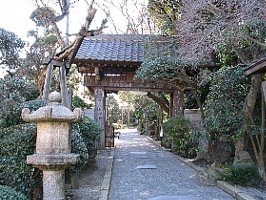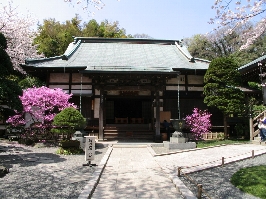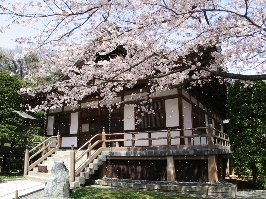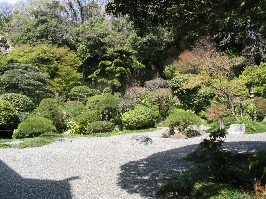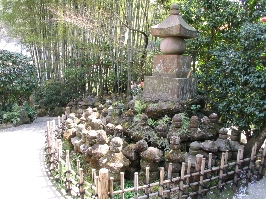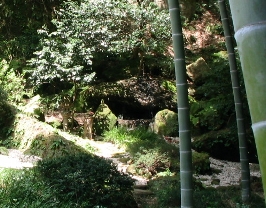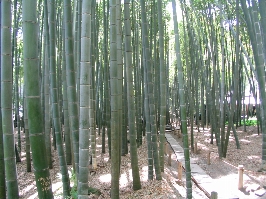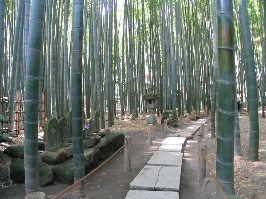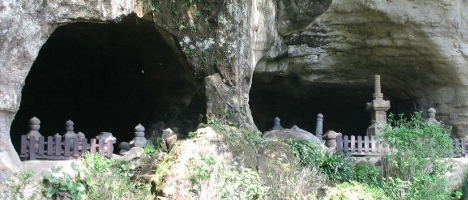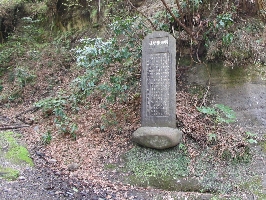 Location: The entrance to the pass is some three and a half kilometers northeast of JR Kamakura Station and 500 meters northeast of Juniso Jinja Mae Bus Stop.
Location: The entrance to the pass is some three and a half kilometers northeast of JR Kamakura Station and 500 meters northeast of Juniso Jinja Mae Bus Stop.The site: A stone marker stands on the right and next to a cascade, Saburo no Taki, literally Saburo Falls. From this point onward, the path goes through dense woods and the winding stream meanders upward while steep cliffs close in from both sides. The area is preserved as a Historic Site by the government. 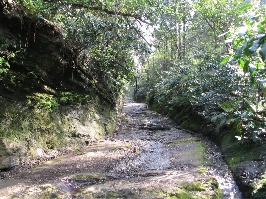
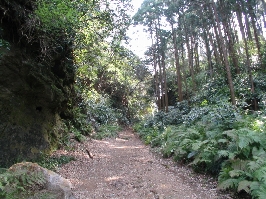
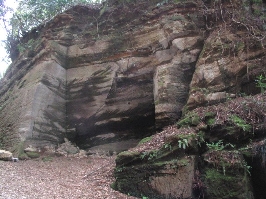
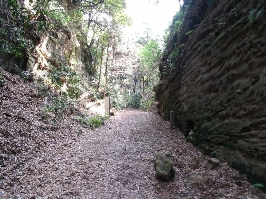
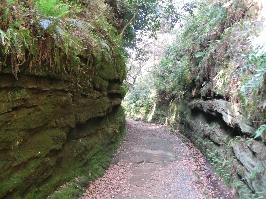
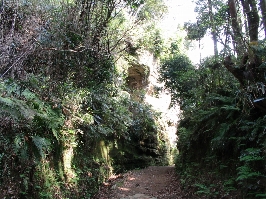
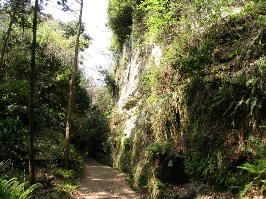
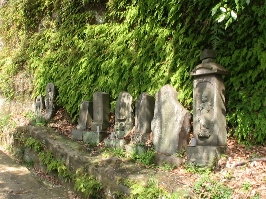
History: Nowadays, the modern paved road runs nearby, but long ago this old path which connected Kamakura with Kanazawa (金沢) and Mutsura (六浦, the old name of present-day Mutsuura) was an important thoroughfare for people and vital goods. In 1240, the Kamakura government, under Hojo Yasutoki (北条泰時, 1183-1242), the third regent, decided to construct a road between Kamakura and Mutsura. The undertaking was so important that Yasutoki himself inspected the construction work. The date of completion, however, was not recorded, even though the project was an official one. On the other hand, because the work was said to have been carried out at top speed, the huge achievement was attributed to a one-night feat by Asahina Saburo Yoshihide (朝比奈三郎義秀, ?-?), a warrior reputed to have been unrivaled in his day. It is from this legend that the Asahina Pass got its name. A cascade next to the stone marker of the Asahina Pass also has his name, being called Saburo no Taki (三郎滝), Saburo Falls. 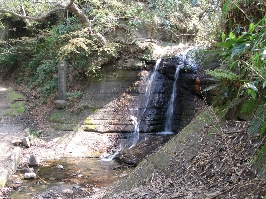
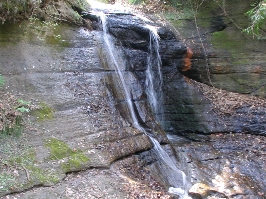 Story: Yoshihide was the third son of Wada Yoshimori (和田義盛, 1147-1213). The father, Yoshimori, came from Wada in the Miura Peninsula, and as a member of the Miura family, served under the command of Yoritomo in the latter's campaign against the Taira and later became the first betto (別当, administrator) of the Samurai-dokoro (侍所), the Board of Retainers. Yoshimori distinguished himself in battle and was greatly trusted by Yoritomo, and much admired by other warriors as an example of an ideal soldier. His son, Yoshihide, also gained a reputation for bravery in battle from an early age. As the years passed, the Wada family became influential in government and the Hojo came to fear Yoshimori and his family. In 1213, Hojo Yoshitoki (北条義時, 1163-1224) provoked Yoshimori into rebellion. Yoshimori, together with his sons and other family members, fought bravely, but finally lost the battle. With almost all of the clan members now dead, Yoshihide saw the hopelessness of the situation and fled to Chiba by boat, hoping to restore their clan there. Nothing more, however, was ever heard of him. |
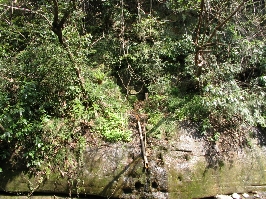
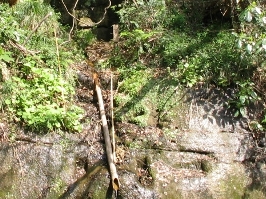
Site: This cascade, called Kajiwara Tachiarai no Mizu, literally "Kajiwara Sword-Washing Water," was counted in old Kamakura as one of the five sources of pure water, Kamakura gomeisui (鎌倉五名水). Nowadays, after rains or in the wet season, clear water flows from between rocks on the hillside. Story: Legend says that Kajiwara Kagetoki (梶原景時, ?-1200), an influential warrior of the Kamakura shogunate, washed his blood-stained sword at this spring after slaying another leading warrior, Chiba Hirotsune (千葉広常, ?-1183). The cause of the event traces back to some years before Minamoto no Yoritomo (源頼朝, 1147-1199) established his government. When Yoritomo took up arms against the Taira clan (平家, the rival of the Genji), Hirotsune, who was in what is now Chiba Prefecture, still sided with the Heike. Although many other warriors were gathering under Yoritomo, he was slow in making up his mind. By the time Hirotsune proudly met Yoritomo, he had already decided in his mind to kill Yoritomo should he find his new master not worth serving. However, when Yoritomo remarked in a grave tone that Hirotsune's joining had come rather late, Hirotsune was so impressed by Yoritomo's dignified attitude that he immediately joined Yoritomo. Hirotsune's military contribution greatly helped Yoritomo succeed in establishing the government in Kamakura. Nevertheless, tension between the two continued. While Hirotsune, a warrior by nature, insisted their activities should be limited to the eastern region, Yoritomo enthusiastically promoted close relations with the courtiers in Kyoto. Ultimately, Hirotsune's attitude led to tragedy. In December 1183, Kajiwara Kagetoki informed Yoritomo that Hirotsune was forming a plot against his master. Under orders from Yoritomo, Kagetoki then visited Hirotsune at his residence in Asahina, and pretended to share time with him. While the two seemingly enjoyed a game of sugoroku (双六, a board game much like backgammon), Kagetoki suddenly slashed out at Hirotsune with his sword, killing him on the spot. Later, Hirotsune was found innocent. With this and other events, Kagetoki earned the disgust of many leading warriors, and was eventually banished from Kamakura. The spring in which Kagetoki washed his bloody sword was thereafter called Tachiarai no Mizu. The residence of Hirotsune is thought to have once stood on the tableland above this spring. |
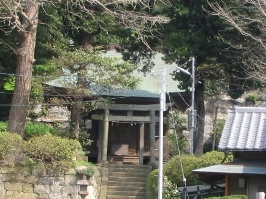
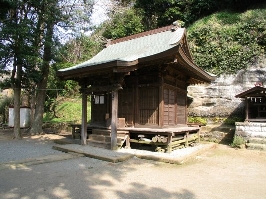
Grounds and structures: Beyond a stone shrine gate, of a myojin-style torii (明神鳥居), lies the main building directly ahead. To the right of the main hall are three small shrines: Yamano Jinja (山の神社), Hoso Jinja (疱瘡神社) and Usa Hachiman Jinja (宇佐八幡神社). A large, heavy-looking stone to the right of the torii is called Hyakukan-ishi (百貫石, or Hyakkan-ishi). The stone, long neglected, weighs roughly 110 kilograms and was once a popular object of weightlifting at shrine festivals. Further to the right stands Kaguraden Hall (神楽殿), for sacred music and dances. 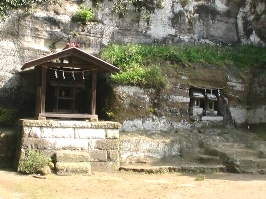
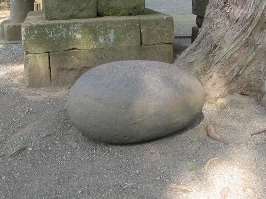
History: Early in the Meiji period (1867-1912), under a government policy of separating Shintoism and Buddhism, the shrine was moved from the grounds of Kosokuji Temple (光則寺) in the neighborhood to its present site and dedicated to seven deities in Heaven and five deities presiding on Earth. At the same time, the name was changed to Juniso Jinja Shrine from Kumano Juniso Gongensha (熊野十二所権現社). Events: A festival is usually held on the first weekend of September and a mikoshi (神輿, portable shrine), is carried throughout the neighborhood. |
Denomination: Ji sect of Buddhism (時宗) Location: Some three kilometers east of JR Kamakura Station and 150 meters northeast of Junisho Bus Stop (十二所バス停). 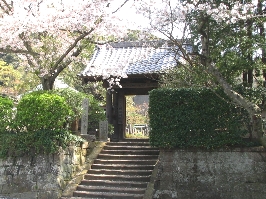
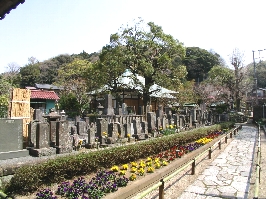
History: The temple originally belonged to the Shingon sect of Buddhism (真言宗). In 1279, when Sakua (作阿), a devotee of Ippen (一遍, 1239-89), the founder of the Ji sect (時宗), became the temple head, he changed the denomination to the present one. The temple once prospered as a place for Ji sect devotees to practice nenbutsu (念仏), repeated recitation of Amida's name. 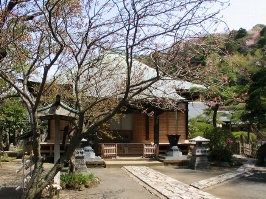
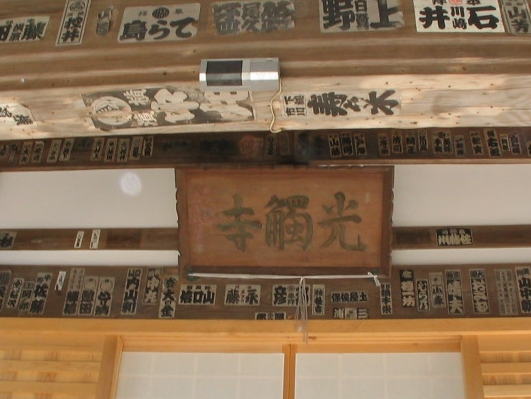
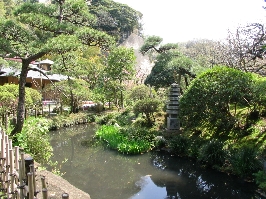
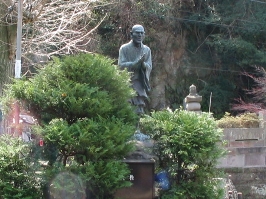
Grounds and structures: Beyond the gate is the approach, lined with seasonal flowers and leading into the grounds. There stands the main hall and to its right is a pond and beyond that an iris garden. The main hall was built in the Edo period (1603-1867), and houses various treasures. Above the entrance hangs a valuable plaque bearing the temple name光触寺 (Kosokuji), engraved in the handwriting of Emperor Go-Daigo (後醍醐天皇, 1288-1339). From outside, the hall appears modest, but the inside has an elaborately constructed sanctuary with a weathered but colorfully decorated ceiling and painted carvings. The main figure here is Amida Nyorai (阿弥陀如来), popularly called Hooyake Amida (頬焼阿弥陀), literally "Burned-Cheek Amida." He is flanked by two attendants, Kannon Bosatsu (観音菩薩) and Seishi Bosatsu (勢至菩薩), and the three are designated Important Cultural Properties. The main image has bold, powerful features typical of the Unkei (運慶) School. Unkei (運慶, ?~1223) was a master sculptor of Buddhist statues in the early part of the Kamakura period. With his father and his son, he formed the Kei School (慶派) of sculpture. One of his masterpieces is a pair of Nio (仁王) statues that stand at the Nandaimon Gate (南大門) of Todaiji Temple (東大寺) in Nara. The masculine, dynamic style he employed appealed to the warriors of the Kamakura period. Another important cultural asset is a scroll, Hooyake Amida Engi (頬焼阿弥陀縁起), "The Tale of Hooyake Amida," depicting the great mercy of Amida. The scroll is now on loan to Kamakura Kokuhokan (鎌倉国宝館), a museum within the grounds of Hachimangu Shrine (八幡宮) . A gigantic head of Buddha, black with soot, and statues of successive priests are at the side and rear of the main altar. Legend: The Hooyake Amida Engi scroll, Important Cultural Property, depicts the story behind the burn mark on Amida's left cheek. One day, a pious lady named Machi no Tsubone (町局) asked Unkei, who was staying in Kamakura, to carve an image of Amida for her to worship in her home. (Whether Unkei actually came to Kamakura has been a point of dispute among historians.) Unkei completed it and, thereafter, Tsubone prayed and chanted in front of it without fail every day. In her house lodged a monk called Manzai (万才). He was very devoted but sometimes became an object of suspicion. One day Machi no Tsubone found a personal item missing. One of her attendants blamed Manzai, and Machi no Tsubone got so furious that she had the monk confined in a small room as punishment. Soon after, she had to go out on urgent business. As she left the house, she ordered her men to brand Manzai on the cheek with a hot piece of metal as punishment. They tried to carry out her orders but were very much surprised when they saw that Manzai's cheek remained as smooth as before. Again and again they tried, but their efforts were in vain. The next night, Machi no Tsubone had a dream in which Amida appeared and sadly pointed to his face and asked why he had been cruelly branded. She saw a mark on his left cheek. Upon awakening, she rushed to the statue and was horrified to see the mark on Amida's face. Amida had taken the place of innocent Manzai. Deeply regretting her deed, she pardoned Manzai. Machi no Tsubone later became a nun and had Ganzoji Temple (岩蔵寺) built in Hikigayatsu (比企ケ谷), where she enshrined this Amida. It is said that Machi no Tsubone died peacefully in front of this statue at the age of 73. For his part, Manzai moved to Oiso (大磯) in the western part of Kanagawa Prefecture, where he lived in a hut and devoted the remainder of his life to chanting sutras, in an effort to spread the virtues of Amida. We are told he, also, led a long and happy life. |
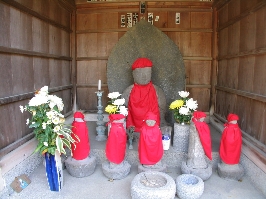
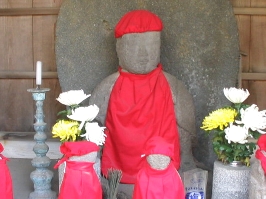
This strangely named statue stands within the grounds of Kosokuji Temple. It is enshrined in a small wooden house, together with six smaller Jizo, the Roku Jizo (六地蔵), guardian deities of the Six Realms of the afterlife: Hell (地獄), Hungry Spirits (餓鬼), Animals (畜生), Bellicose Spirits (阿修羅), Human Beings (人間), and Heaven (天). In earlier days, the statue stood beside the main road where many people passed by. The name of this Jizo derives from the following story: In the early days, salt sellers offered the Jizo a portion of their salt on their way to the town of Kamakura because they hoped for a successful trade. On their return, they always noticed that the salt was gone. They innocently believed Jizo had graciously tasted it and would give them luck. The legend attests the importance of this road for transportation of daily necessities such as salt. |
Denomination: Shingon sect (真言宗) Location: Some three kilometers east of JR Kamakura Station and 200 meters north of Sensuibashi Bus Stop. 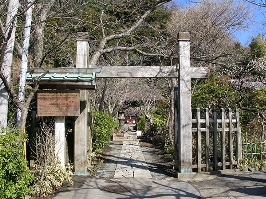
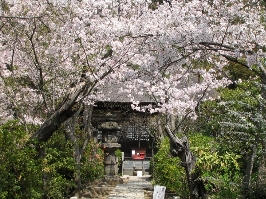
History: The temple was built in 1235 by order of Fujiwara no Yoritsune (藤原頼経, 1218-56). He became the fourth shogun in 1226 after the assassination of Minamoto no Sanetomo (源実朝, 1192-1219), the third shogun in 1219; Yoritsune was the last of the direct lineage of Yoritomo. This area was to the northeast of the seat of government. According to an old belief, the area northeast of a focal point was called kimon (鬼門), an unlucky direction from which the evil spirits entered and first had to be exorcised. The result of it was that Yoritsune had Godaido Hall (五大堂) built to ward off the possibility of any evil influence. Godai Myoo (五大明王), five great deities with angry visages for warding off evil, were enshrined in Godaido Hall: Fudo Myoo (不動明王) in the center; Gosanze (降三世) in the east; Daiitoku (大威徳) in the west; Gundari (軍荼利) in the south; and Kongoyasha (金剛夜叉) in the north. With the exception of the statue of Fudo Myoo, all the above were destroyed in fires, and the present ones are replacements. In the Shingon sect, priests performed a ceremony called godan-no-ho (五壇の法) in the imperial palace and residences of court nobles to pray for the cessation of calamities and an increase in good fortune. The Godai Myoo were the central deities of worship in this ceremony, which means that this temple must have played an important role in such rituals. 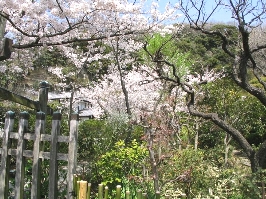
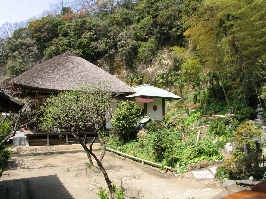
Grounds and structures: The temple and its grounds are now modest in size, but the two halls harmonize serenely with the trees and surrounding hills. The main hall is somber-looking yet attractive. Its roof is thatched and its windows latticed. The main hall now houses statues of Godai Myoo with Fudo Myoo in the center, flanked by statues of Yakushi Nyorai (薬師如来), Dainichi Nyorai (大日如来), Fujiwara no Yoritsune, and Inari (稲荷) holding a spear with a sickle-like blade attached. |
Site: There is no trace of the dwelling now and only a stone marker stands to mark the site. 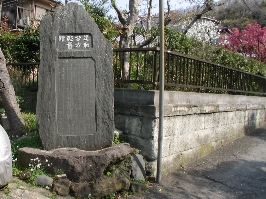
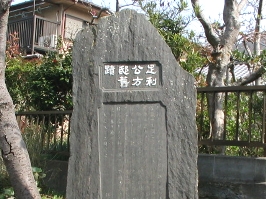
History: During the Muromachi period (1336-1573), the term kubo (公方) referred to both the Ashikaga (足利) shoguns in Kyoto and their deputies from the same family in the Kanto region. After Ashikaga Takauji (足利尊氏, 1305-58) established the Muromachi bakufu (室町幕府) in Kyoto in 1336, he set up a branch shogunate known as Kamakura-fu (鎌倉府) in 1349 to rule the Kanto region. He appointed his second son, Ashikaga Motouji (足利基氏, 1340-67), as the first Kamakura Kubo. Motouji's descendants succeeded to this position until Ashikaga Shigeuji (足利成氏, 1438-97) moved to Koga (古河, in present-day Ibaraki Prefecture) in 1455. The second-highest position in Kamakura-fu was called Kanto Kanrei (関東管令), the shogunal deputy for the Kanto region. Taking turns in this position were the four branch families of the Uesugi: the Yamanouchi (山内), Ogigayatsu (扇谷), Inukake (犬懸), and Takuma (宅間). |
Denomination: Rinzai sect (臨済宗) Location: Two kilometers northeast of JR Kamakura Station. 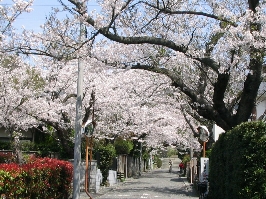
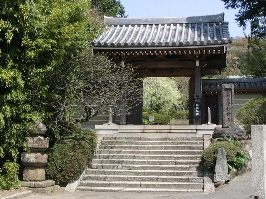
History: Tradition says that Ashikaga Yoshikane (足利義兼, ?-1199), an influential retainer of the Kamakura bakufu, founded the temple by inviting Taiko Gyoyu (退耕行勇, 1163-1241) to be its first priest. The temple was first named Gokurakuji (極楽寺), belonged to the Shingon sect (真言宗). It was converted to the Rinzai Zen sect when Ashikaga Yoshiuji (足利義氏, 1189-1254), a son of Yoshikane, came to support it Furthermore, Ashikaga Sadauji (足利貞氏, 1273-1331), the father of Ashikaga Takauji (足利尊氏, 1305-58), greatly contributed to the temple. In his honor, the temple name was later changed to Jomyoji, which is part of his posthumous name, Jomyojiden-Teizan-Dokan, 浄妙寺殿貞山道観. 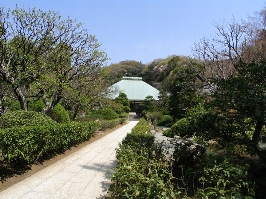
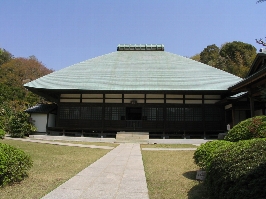
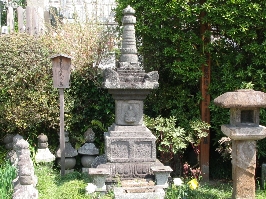
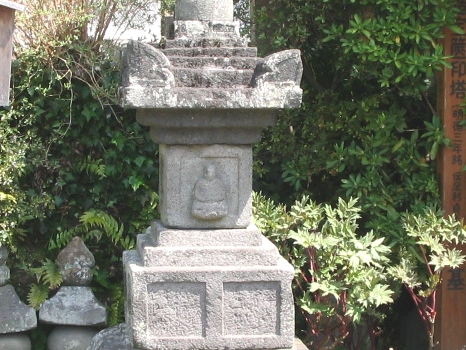
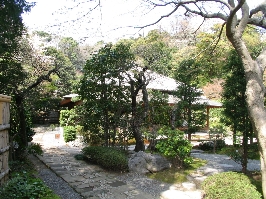
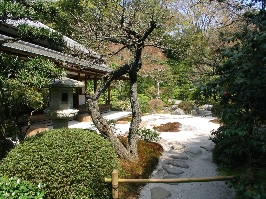
Grounds and structures: Cherry trees lining both sides of the approach to Somon Gate (総門) come in full bloom in spring. The grounds are not so spacious, but are full of seasonal flowers and well-trimmed trees. In its heyday, the temple boasted massive structures befitting its position as one of the five most prominent Zen temples, the Kamakura Gozan (鎌倉五山). Jyomoyji still retains its dignity, although the buildings are now very modest. The main hall stands in the center of the precincts, and a new guest hall and the priest's living quarters are to the east, with kaisando hall (開山堂, founder's hall) behind the main hall. The grounds have been designated a Historic Site by the government. The main hall houses two treasures: a statue of Shaka Nyorai (釈迦如来) and a statue of Amida Nyorai (阿弥陀如来). A statue of Awashima Myojin (淡島明神), the deity for gynecological diseases, is also there. In founder's hall is a statue of the celebrated priest, Taiko Gyoyu, who was the first to officiate at the temple. The statue is designated an Important Cultural Property. Also in this hall are a statue of Fujiwara no Kamatari (藤原鎌足, 614-669), an ancestor of the Fujiwara clan who prospered in the Heian period (794-1185/92), and a statue of Sambo Kojin (三宝荒神), a Buddhist deity who is popularly believed to reside in kitchen hearths and prevent fires. In the graveyard behind the main hall stands a hokyointo-type (宝篋印塔) stone stupa, reportedly the grave of Sadauji. One of the inscriptions on it is an era name, 明徳三年 (corresponding to the year 1392). Whether it is the actual grave of Sadauji has been questioned because the inscribed year is some 60 years later than his recorded death. 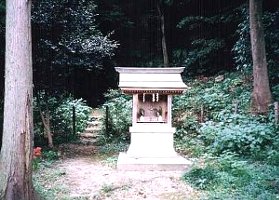 On the right side of the grounds is a small shrine called Kamatari Inari (鎌足稲荷). Despite its insignificant appearance, the shrine dates from the seventh century and is historically important, as can be seen from the following story.
On the right side of the grounds is a small shrine called Kamatari Inari (鎌足稲荷). Despite its insignificant appearance, the shrine dates from the seventh century and is historically important, as can be seen from the following story.Story: A plaque next to the Shrine reads as follows: As an infant, Lord Fujiwara no Kamatari was given a sickle by the Inari no Kami. By keeping the sickle with him at all times as a charm, Lord Fujiwara no Kamatari was granted the protection of the deity. In 645 A.D. he joined Nakano-oe-no-oji (later the Emperor Tenchi) to vanquish the noble Soga-no-Iruka and thus succeeded in fulfilling his greatest wish. Lord Fujiwara no Kamatari then headed for the eastern provinces of Japan in 646, stopping at Yui-no-sato in Sagami. That night, he received a message from the Inari no kami, who told him, "I gave the sickle to you and have protected you ever since, but now you have achieved your greatest wish by defeating Iruka, so you must return the sickle to me and to the land." Doing as he was bidden, Lord Kamatari buried the sickle, and this action and his prayers offered up to the god were the beginning of the Kamatari Inari Jinja. The place name Kamakura is said to signify the location where Lord Kamatari buried the sickle, or "kama." |
